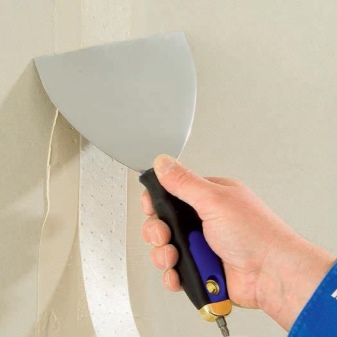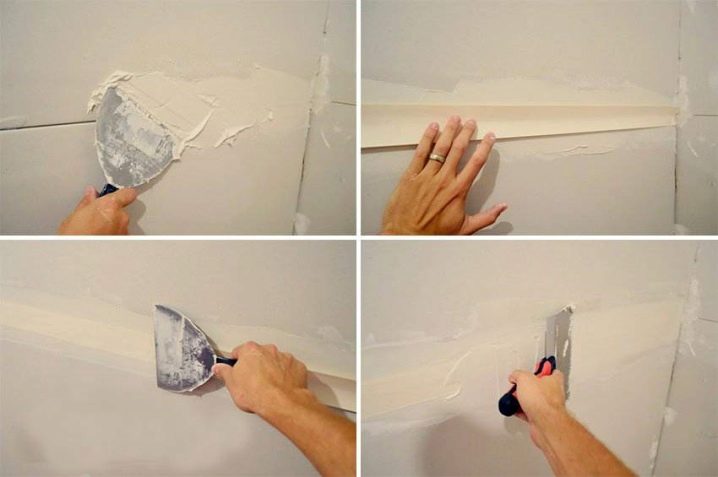Knauf plasterboard reinforcing tapes: types and their characteristics

To create flat and smooth walls in the room at the stage of construction of apartment buildings, plasterboard sheathing is used. The level of moisture resistance and fire resistance of the coating depends on their quality. Therefore, professionals give preference to gypsum plasterboards produced by the famous German company Knauf.
After finishing the room with such material, a space with perfect walls is obtained. But the joy of the work done can ruin the unsightly appearance of the joints between the sheets. Oblique cuts around the edges of the material may be the cause.

There is a simple way out of this situation - to plaster the surface of the sheets with mixtures intended for gypsum board joints and use a reinforcing tape.
It is important that both the tape and the mixture are ideal for Knauf drywall, because it depends on the compatibility of building materials whether the result of the repair will be successful or unsuccessful.
Competent design of the joints formed during the installation of plasterboard sheets guarantees not only aesthetics, but also the strength of the structure, because any damage can cause the appearance of small, but dangerous for the construction of holes and cracks.


Why do you need a reinforcing tape
If the walls are putty without reinforcement, after a while, due to temperature changes, the plaster will crack at the points of contact of the sheets. In the future, these gaps will only increase, which will lead to the need for new, better quality repairs.
That is why it is necessary to use plasterboard reinforcing tape. In addition, the use of this material contributes to the formation of a smooth and even surface.

Types and characteristics
Recently, builders have preferred several types of belts.
Perforated paper
Perforated paper tape is a highly durable fiberglass-reinforced paper. In order to provide the best adhesion, manufacturers have made the adhesive side rough, that is, perforated. To make gluing the corners more convenient, the material was equipped with a depressed fold in the middle, so the tape is used as an angle-forming tape.
Knauf can also offer a special corner protection tape Knauf-Alux, which is made of special paper with metal inserts. Such a tape will be able to withstand both stretching and creasing. It can be called sealing, as it is often used to strengthen and increase the strength of structures. This tape is sold in rolls of 50 m, 75 m or 153 m.
However, this material also has minor disadvantages. The process of mounting the paper tape is quite laborious. If you are not experienced with this material, air bubbles may form under the tape during the seaming step. Insufficient amount of putty under the tape may be the reason. Therefore, it is necessary to thoroughly coat all seams with a joint mixture. It is also best to opt for micro-perforated paper tape.



Serpyanka
Self-adhesive serpyanka is a mesh produced in strips of 45 or 50 millimeters wide. For gluing this material, no special compounds are required, since it already has an adhesive base. Serpyanka is made of fiberglass fibers, which are particularly reliable, in rolls 20, 45 and 90 meters long.
Fiberglass reinforcing tape can be an excellent example of serpyanka. Knauf-Fireboard for slabs and various joints.
You can also purchase a cheaper version - without a strip of glue. Such products, in turn, are fixed with a construction stapler.


In addition to the advantages, Serpyanka also has several disadvantages:
- lower level of strength than paper tape;
- the importance of choosing a solution that is absolutely suitable for serpyanka;
- the need for thorough cleansing of the joints (otherwise, "wrinkles" may form);
- the need to monitor the uniformity of the distribution of the putty layer over the entire joint.


When using a self-adhesive serpyanka in the procedure, at the end of the work, it is better to pack the rest of the tape in a plastic bag. Otherwise, the glue will dry out over time, and the material will be unusable in the future.
When choosing a material for sealing joints, you need to pay attention to an important feature. Longitudinal seams on drywall are sealed with serpyanka, and transverse seams with paper tape.


Damper
If it is necessary to put drywall on the floor, then a damper or waterproofing tape will be needed for a successful installation. It is made of polyethylene foam, which has the ability to taper. This allows the material to substantially compensate for the expansion of plasterboard floors.
Interestingly, it was Knauf who first proposed to cover the floor with plasterboard.

This solution has a lot of advantages:
- Installation is carried out on a dry floor. This makes it possible to exclude constant humidity in the premises.
- Installation can be done quickly and easily by yourself.
- Plasterboard does not load the overlapping slabs, as the material has a low mass.
- The low price of drywall sheets is a nice bonus.
- The material is easy and simple to process.
- Plasterboard sheets enhance sound and heat insulation.


However, drywall sheets are very porous. Moisture can easily penetrate them, which can cause them to swell. Therefore, between the wall and the drywall, it is necessary to lay a special waterproofing tape, for example, Knauf Flehendihtband, designed to waterproof the joints of walls and ceilings.

Setting material
For Knauf drywall, it is better to choose sealing materials from the same manufacturer. For example, you can purchase a tape Knauf-kurt in rolls of 25 m or paper tape 52x150xS. The latter is made of special white paper, which includes reinforcing synthetic fibers.


The installation of the paper tape is carried out in a certain sequence:
- First, you need to apply a thin layer of putty, but only on the joint that you decided to seal at the moment. The putty cannot be applied to everything at once, otherwise the mixture will dry out and become useless, and the work will be more difficult due to the likely occurrence of air bubbles.
- The mesh is adjusted with two central seams. You need to keep it constantly taut. With a little effort, you need to press the tape against the putty layer. The ends of the material must be overlapped.
- Then it is necessary to smooth the tape with two spatulas, strictly following from the center to the sides of the seams. It is important to exert sufficient effort to ensure that the material adheres securely to the joint and that the excessive amount of mortar is squeezed out. There should be about 0.8 millimeters of the mixture under the edge of the paper, and about 2 millimeters under the center. It is important to take into account that if too much mixture is squeezed out, then the tape will not be able to stick.


- After the successful completion of all manipulations, you need to remove excess putty from the edges.
- After some time, you need to finally smooth out the seam with a spatula with a wide blade (more than 100 millimeters). It is important that the seam does not go beyond the plane of the drywall.
- At the end of the work, it is necessary to sand the layer well.


Installing the self-adhesive mesh is much less time consuming. This is because there is no risk of air bubbles. The process itself is also divided into several stages:
- Before starting the installation, prepare a putty mortar and apply it in a thin layer to the joint, using a spatula with a width of 40 to 50 millimeters.
- Then, without delay, you need to attach the edge of the mesh to the top edge of the seam and press it slightly against the plaster. At the same time, you cannot press hard. This can provoke the appearance of "wrinkles" on the mesh or lead to damage to the tape from strong mechanical stress.
- The roll should be unrolled to the bottom, gluing the tape along the gypsum board and smoothing it with a spatula.


- At the floor, the mesh must be cut.
- Then you should again "walk" along the mesh, smoothing out the wrinkles that have arisen.
- From above, the serpyanka must be covered with another layer of plaster and left to dry completely.

Self-adhesive serpyanka can be simply fixed on a dry surface, and covered with a thin layer of plaster on top.
The damper tape must be installed slightly above the level of the floor screed. Usually, when laying drywall on the floor, builders leave a small gap about 1 centimeter wide, in which they then lay a waterproofing tape and glue it between the wall and the floor. After that, the tape is covered with dry powder for installation.


Reviews
Reviews of Knauf materials are extremely enthusiastic. This is natural, because the reinforcing tapes produced by the company are of high quality.
Manufacturing technologies that are far ahead of their time ensure the reliability and durability of belts, as well as the convenience of the material in use.
All these characteristics are confirmed by satisfied customers who use suitable reinforcing tapes for Knauf drywall.

See below for the advantages of Knauf gypsum plasterboard reinforcement tape.













The comment was sent successfully.